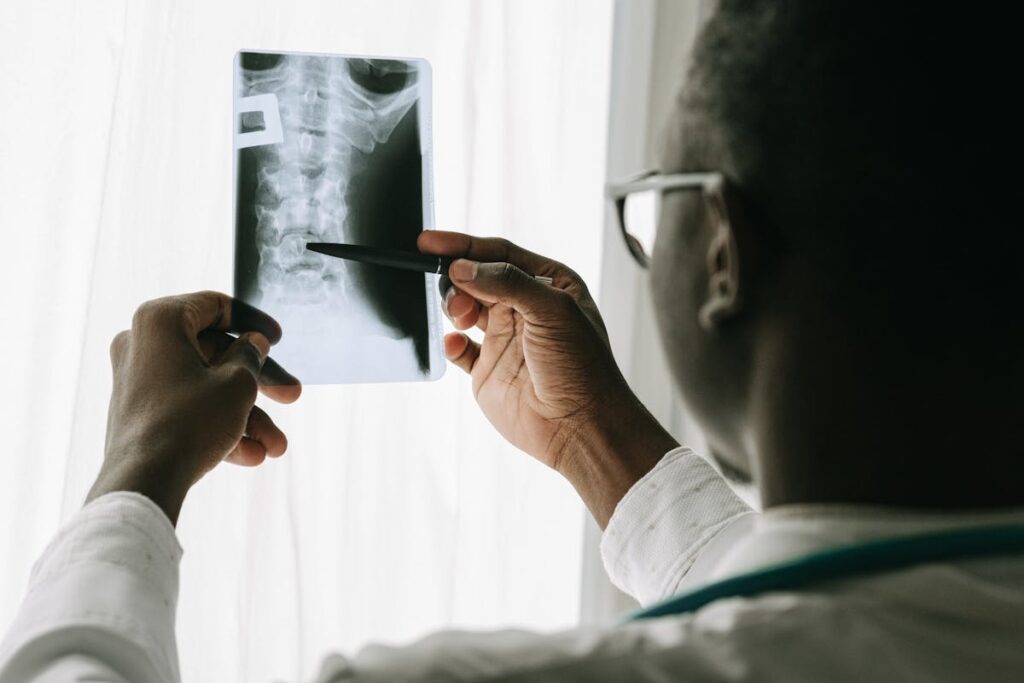The diverse landscape of treating spinal compression fractures is an intricate blend of pain management, physical therapy, and surgical intervention, together with a healthy focus on nutrition – particularly calcium and Vitamin D – for ideal bone health. These treatments, ranging from non-invasive to minimally invasive procedures such as vertebroplasty and kyphoplasty, not only offer immediate relief but also promise to restore affected individuals’ mobility. However, as we navigate the complexities of these treatments, one wonders, what are the potential risks and benefits associated with each, and how can we best tailor these interventions to individual patients?
Understanding Spinal Compression Fractures
A spinal compression fracture, a medical condition often associated with significant discomfort and debilitating consequences, is a vital concept to comprehend in the field of orthopedic health. This condition often stems from osteoporosis, trauma, or certain types of cancer, underscoring the importance of understanding fracture causes. The fracture typically occurs when the vertebral body of the spine collapses, leading to a variety of symptoms. Symptom awareness is fundamental for early detection and intervention. Patients may experience sudden, severe back pain, worsening pain upon standing or walking, a decrease in height, or a stooped posture. In some cases, there may be no apparent symptoms, making regular health checks essential. Understanding these aspects is key to facilitating ideal patient outcomes.
Pain Management Through Medication
Managing pain associated with spinal compression fractures often necessitates the use of pharmaceutical interventions. Non-steroidal anti-inflammatory drugs (NSAIDs) and opioid analgesics constitute two primary categories of such medications. An exploration of the efficacy, administration, and potential side effects of these treatments forms an essential component of thorough patient care.
Non-Steroidal Anti-Inflammatory Drugs
Although the severity of pain can vary greatly, Non-Steroidal Anti-Inflammatory Drugs (NSAIDs) often serve as a frontline treatment for managing discomfort associated with spinal compression fractures. NSAIDs work by reducing the body’s production of substances that cause inflammation and pain. They provide an effective, albeit temporary, relief for patients.
However, prolonged use of NSAIDs can lead to side effects such as gastrointestinal problems and increased cardiovascular risk. Consequently, many patients seek natural remedies and alternative therapies to supplement or replace NSAID use. These may include nutritional supplements like omega-3 fatty acids known for their anti-inflammatory properties, or physical therapies such as yoga and acupuncture. A well-rounded, personalized treatment plan often combines NSAIDs with these complementary approaches for best results.
Opioid Analgesics Use
In the domain of pharmacological intervention for spinal compression fractures, opioid analgesics represent a potent, albeit controversial, option. These medications effectively mitigate severe pain, but their use may lead to opioid dependence, a challenging and dangerous clinical condition. The risk of dependence necessitates careful monitoring of patient’s usage and frequent reassessment of their pain.
While opioid analgesics provide significant pain relief, healthcare providers should consider alternative therapies before initiating opioid treatment. Non-pharmacological interventions, such as physiotherapy, and less potent analgesics, may provide sufficient management of symptoms for many patients. Balancing the need for effective pain relief against the potential for dependence and adverse effects is a critical component of managing spinal compression fractures.
Role of Physical Therapy
Physical therapy plays a pivotal role in recovery from spinal compression fractures, providing both immediate and long-term benefits. Initially, a careful and tailored exercise regimen can aid in patient mobilization, reducing the risk of complications such as deep vein thrombosis. Additionally, specific physical therapy techniques can help patients regain strength and flexibility, ultimately improving their quality of life post-injury.
Exercise Regimen for Recovery
While the process of recovering from a spinal compression fracture can be arduous, incorporating a tailored exercise regimen under the guidance of a physical therapist can greatly enhance the healing process. Strength training and flexibility exercises form the core of this regimen. Strength training, often involving resistance bands or light weights, targets specific muscle groups that support the spine, thereby improving stability and reducing strain on the affected area. Flexibility exercises, on the other hand, aim to keep the joints limber, minimizing stiffness and facilitating better movement. It’s important to recognize that these exercises must be individually customized, considering the patient’s health status, pain tolerance, and progress in recovery. This balanced approach promotes a thorough, efficient, and safe recovery.
Physical Therapy Techniques
Building upon the foundation of a well-structured exercise regimen, physical therapy takes a more thorough approach towards the treatment of spinal compression fractures. This all-encompassing approach is designed to address specific functional impairments and improve overall mobility. It involves a combination of stretching techniques and strength training exercises that promote spinal stability and flexibility. Proper stretching techniques are implemented to enhance range of motion and alleviate muscle stiffness often associated with spinal fractures. Strength training, on the other hand, focuses on reinforcing the supporting musculoskeletal structures, reducing the pressure on the spine. These techniques, when administered under the supervision of a skilled physical therapist, can greatly contribute to the management and recovery from spinal compression fractures.

Importance of Proper Nutrition
Ideal nutrition plays an essential role in the treatment and recovery from spinal compression fractures. A balanced intake of vitamins and minerals, particularly Calcium and Vitamin D, are vital for bone health. These nutrients can be obtained through a wholesome diet or via dietary supplements, if necessary. Nutrient absorption is also a significant factor; the body must effectively absorb these nutrients for them to be beneficial. Conditions such as gastrointestinal disorders can hinder proper absorption, negatively affecting recovery. Additionally, protein is key for tissue repair and muscle support around the spine. Water, too, is essential for maintaining disc health. Hence, a well-rounded nutritional strategy can facilitate healing, reduce pain, and bolster overall health in patients with spinal compression fractures.
Exploring Vertebroplasty Procedure
Having discussed the role of nutrition in healing spinal compression fractures, we now turn our attention to an interventional treatment approach known as vertebroplasty. As an outpatient procedure, vertebroplasty involves the injection of a bone cement into the fractured vertebra to provide immediate stability and pain relief. Among the vertebroplasty benefits are a significant decrease in pain levels, restoration of vertebral height, and improved mobility, often within 24 hours. However, it is important to recognize the vertebroplasty risks, which include infection, bleeding, increased back pain, and cement leakage into surrounding areas. As with any medical procedure, it is vital to weigh the potential benefits against the risks, in consultation with a knowledgeable spine specialist.
Kyphoplasty: A Surgical Option
Delving into the domain of surgical options, kyphoplasty emerges as a viable treatment for spinal compression fractures. This surgical procedure involves the insertion of a balloon into the fractured vertebra, which is then inflated to create a cavity. The cavity is subsequently filled with a type of bone cement, restoring the height and shape of the vertebra. Among the kyphoplasty benefits are the potential to provide immediate pain relief, correct spinal deformities, and prevent further fractures. However, like all surgical procedures, there are risks. These may include infection, cement leakage, and risks associated with anesthesia. Nevertheless, kyphoplasty offers a promising surgical option for patients with spinal compression fractures, especially those unresponsive to conservative treatments.
Minimally Invasive Procedures
When it comes to treating spinal compression fractures, minimally invasive procedures offer a less aggressive alternative to traditional open surgery. These techniques, often performed through small incisions, reduce the trauma to surrounding tissues and generally result in fewer complications. Furthermore, the recovery period tends to be shorter, enabling patients to return to their daily routines more swiftly.
Minimally invasive techniques such as vertebroplasty and kyphoplasty involve the injection of bone cement into the fractured vertebrae, stabilising the spine and alleviating pain. These procedures, performed under local or general anaesthesia, often provide immediate relief and improved mobility. Given these advantages, minimally invasive procedures have become an essential part of the treatment landscape for spinal compression fractures, prioritising patient recovery and quality of life.
Lifestyle Changes for Long-Term Relief
While minimally invasive procedures can provide immediate relief for spinal compression fractures, sustained improvement often requires certain lifestyle modifications. Among these, posture improvement stands as one of the most important. Adopting an upright stance while sitting or standing can greatly relieve the pressure on the spinal cord. Regularly practicing exercises focusing on spinal alignment may foster better posture habits. Additionally, weight management plays an essential role in maintaining spinal health. Excessive weight can exert undue stress on the spine, exacerbating the pain and discomfort associated with compression fractures. As a result, incorporating a balanced diet and regular exercise into daily routines may contribute to weight control, thus reducing the strain on the spine and promoting long-term relief.
Frequently Asked Questions
What Are the Potential Risks or Complications of Spinal Compression Fracture Treatments?
Potential risks of spinal compression fracture treatments include surgical risks such as infection, nerve damage, or bleeding, and non-surgical complications like ineffective pain relief, worsening bone loss, and prolonged immobilization leading to muscle weakness.
Are There Any Alternative Treatments for Spinal Compression Fractures?
Yes, alternative treatments for spinal compression fractures include acupuncture therapy, which can help manage pain, and chiropractic adjustments, which may improve spinal alignment and mobility, though these should be guided by a healthcare professional.
How Does Age Affect the Recovery Process of Spinal Compression Fractures?
Age notably influences the recovery process of spinal compression fractures. Age-related factors like slower cell regeneration and existing comorbidities can pose recovery challenges, potentially prolonging healing times and influencing the effectiveness of various treatment options.
What Is the Average Recovery Time for a Spinal Compression Fracture?
The average recovery time for a spinal compression fracture varies, typically spanning 6-12 weeks. This period often includes a regimen of rehabilitation exercises and pain management protocols to promote healing and restore functionality.
Can Spinal Compression Fractures Recur After Successful Treatment?
Yes, spinal compression fractures can recur after successful treatment. Recurrence factors include osteoporosis and high-impact activities. Preventive measures include medication for bone strengthening and lifestyle modifications such as low-impact exercise and proper body mechanics.
